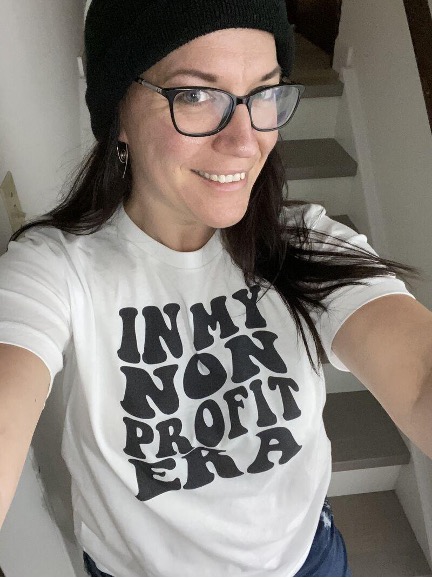- Home
- About Us
- The Team / Contact Us
- Books and Resources
- Privacy Policy
- Nonprofit Employer of Choice Award

If you work in a nonprofit, you’ve probably been told you need to “show up on social.” Build a Facebook group. Post more on Instagram. Run a campaign on LinkedIn.
And while social media can be a useful tool, here’s the trap: a social media audience is not the same thing as building a community.
A social media audience consumes.
A community participates.
A social media audience watches.
A community co-creates.
Too often, Canadian nonprofits equate “activity on platforms” with “building belonging.” But as many organizations are discovering, more posts don’t necessarily mean more connection.
I was reminded of this recently in a conversation with Maia Iva, a nonprofit founder originally from Ukraine, whose experience offers a powerful lesson for our sector.
Maia’s Story: From Broadcast to Belonging
When Russia’s full-scale invasion of Ukraine began, Maia and her small team realized that animals would be among the hidden casualties of war. Within two months, they had rescued and rehomed 70 animals across Europe. They later shifted to feeding and supplying stray animals in dangerous regions." - most stray animals aren't left behind, they've always been there — supporting more than 100,000 animals to date.
At first, Maia tried what so many nonprofits do: relying on social channels to get the word out. But she found herself in a familiar trap. Groups were full of posts, but not much actual connection. People clicked “like” and scrolled away.
Her breakthrough came when Petners started participating in events and having 1-1 conversations with their audience both online and offline. This way, true connections were being built - human to human instead of nonprofit to donor. A simple DM to a new follower resulted in a donation, a direct line to the org's team resulted in opportunities brought in by supporters.
Small event participations (having a stand at a Christmas market) led to supporters coming by to say hi and meet in person, as well as new people learning about Petners by meeting the team.
After a true community was built, it was time to take the next step - reaching out to corporate partners.
Maia wrote a cold email to a vegan pet food brand she admired. Within ten minutes, the founder replied. That message led to a partnership worth 32 tons of pet food — enough to feed 250,000 animals.
Corporate partners are interested in tapping into strong communities, no matter the follower count.
She later secured celebrity endorsements the same way: through authentic outreach and mission alignment, not polish or a perfect pitch deck.
The lesson? Authenticity + alignment beats polish every time.
Why small Canadian nonprofits have the advantage
In Canada, we sometimes assume the “big wins” only go to big nonprofits. But Maia’s story is proof that smaller, scrappier organizations can secure partnerships faster — not in spite of their size, but because of it.
A smaller nonprofit can:
It’s often easier for a partner or supporter to connect with the real human energy behind a small nonprofit than with a polished but impersonal brand.
Reframing marketing: Ask, connect, co-create
So, how can Canadian nonprofits move beyond the “broadcast” mindset and into true community building?
I suggest a simple reframe: Ask. Connect. Co-Create.
Ask. Don’t wait for people or companies to find you. Proactively reach out to mission-aligned partners, even if they feel out of reach. Maia’s cold email is a perfect example. Closer to home, many small Canadian organizations find success by simply asking local businesses, unions or service clubs for support — not in a polished campaign, but in a genuine, values-aligned conversation.
Connect. Marketing isn’t about impressions. It’s about sparking meaningful exchanges. At The Nonprofit Hive, we’ve built our model around weekly 1:1 Hive Chats — short video calls that connect nonprofit professionals across the country and the world. A single conversation builds more trust than 100 social media likes ever could.
Co-Create. Bring your community into the process. At the Hive, our members write “Hive Mind” articles, share resources, and even shape sponsorships. In your nonprofit, this could look like inviting volunteers to share their stories, asking board members to co-host events, or spotlighting staff voices on social media. When people see themselves in the work, they become natural advocates.
Practical takeaways for Canadian nonprofits
Here are a few experiments you can try right away:
The Canadian context
Canada’s nonprofit sector is unique. Much of our social infrastructure — food banks, shelters, crisis lines, cultural organizations — depends on grassroots nonprofits. They are often underfunded, understaffed, and yet deeply trusted in their communities.
That trust is our sector’s greatest strength.
By resisting the urge to equate “being on social” with “building community,” Canadian nonprofits can lean into what we do best: showing up authentically, aligning around shared values, and creating spaces where people belong.
Marketing isn’t just about being seen. It’s about being shared. Being joined. Being believed in.
And when nonprofits ask, connect, and co-create, they’re not just doing marketing. They’re building movements.
 Tasha Van Vlack is a community strategist and the founder of The Nonprofit Hive, where she builds one-to-one connections between nonprofit professionals for peer learning and support. She’s also the creator of Community Hives, a tool helping associations and networks scale meaningful member engagement. Across all her work, she’s focused on making connection easy, impactful, and human.
Tasha Van Vlack is a community strategist and the founder of The Nonprofit Hive, where she builds one-to-one connections between nonprofit professionals for peer learning and support. She’s also the creator of Community Hives, a tool helping associations and networks scale meaningful member engagement. Across all her work, she’s focused on making connection easy, impactful, and human.